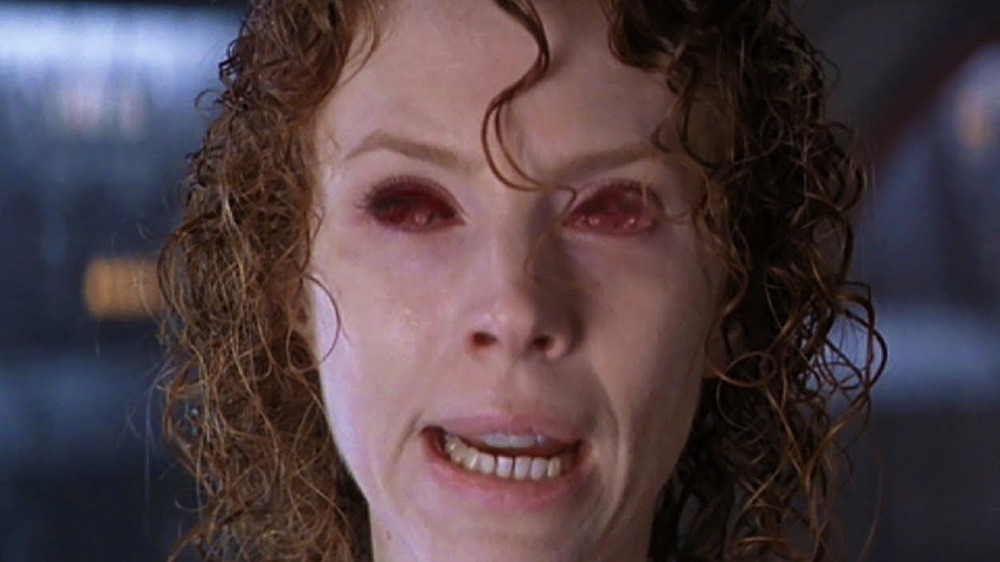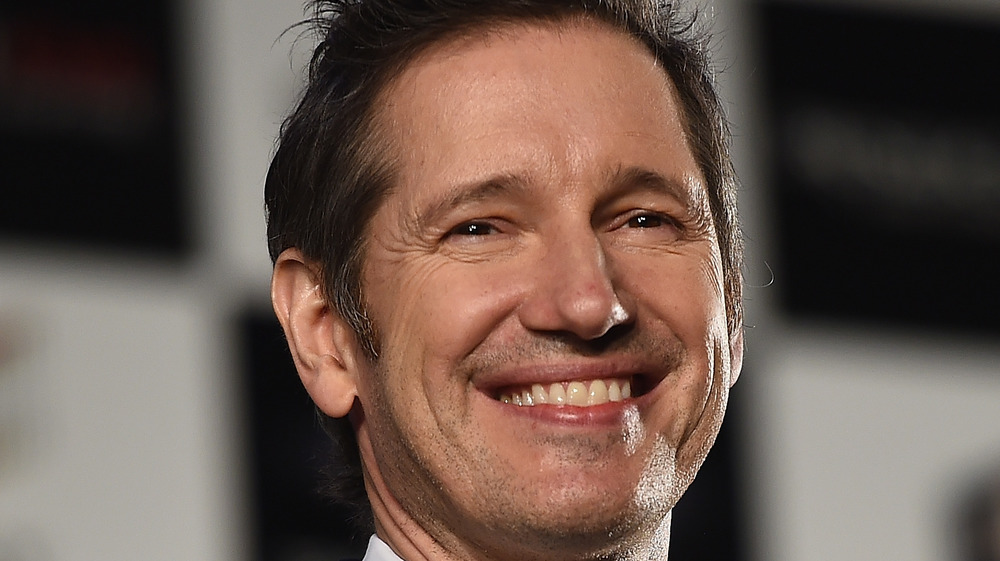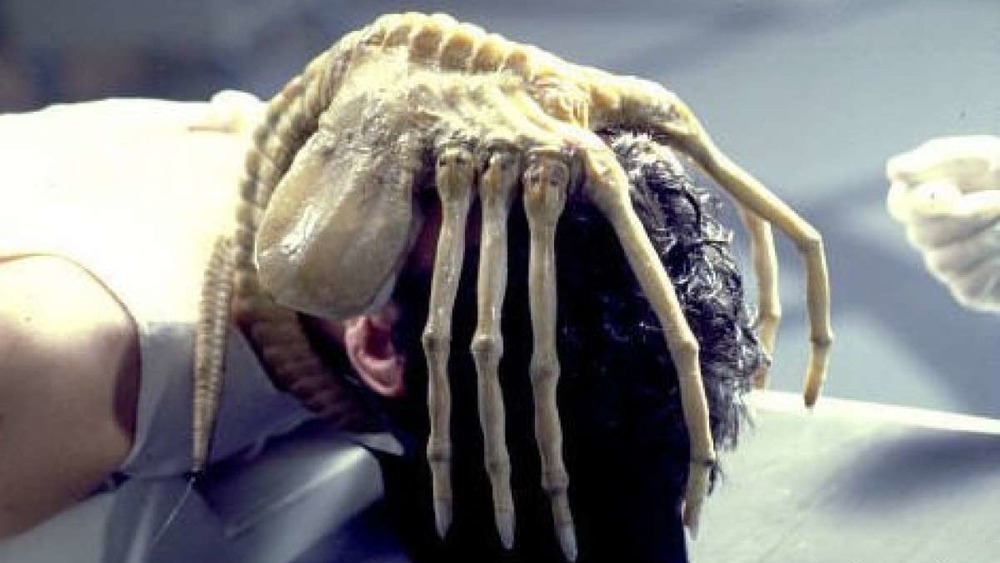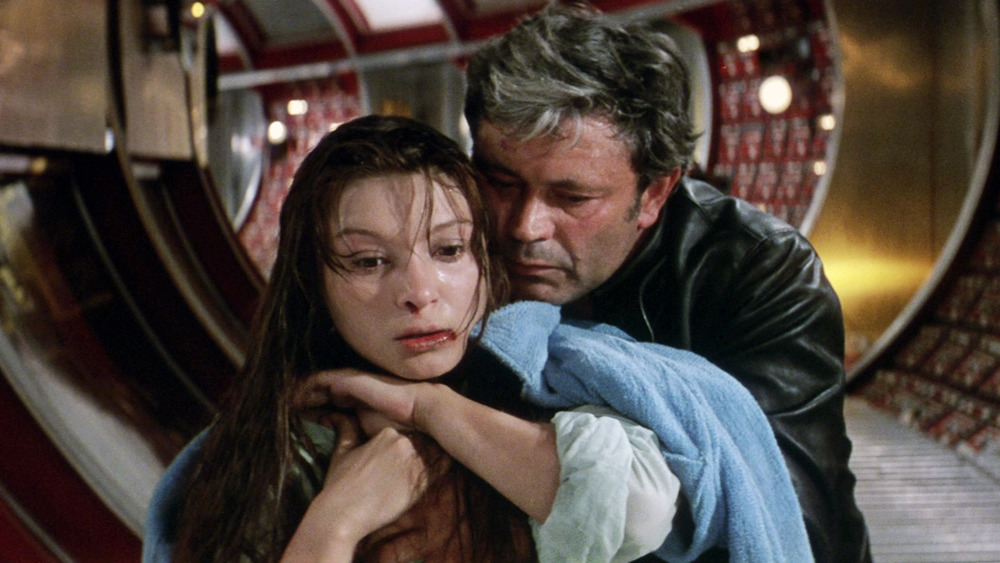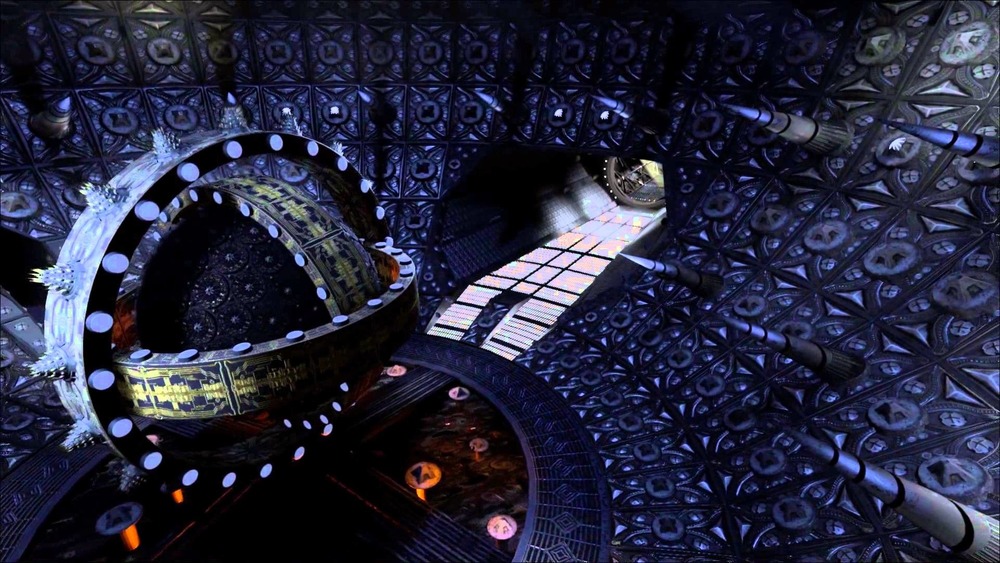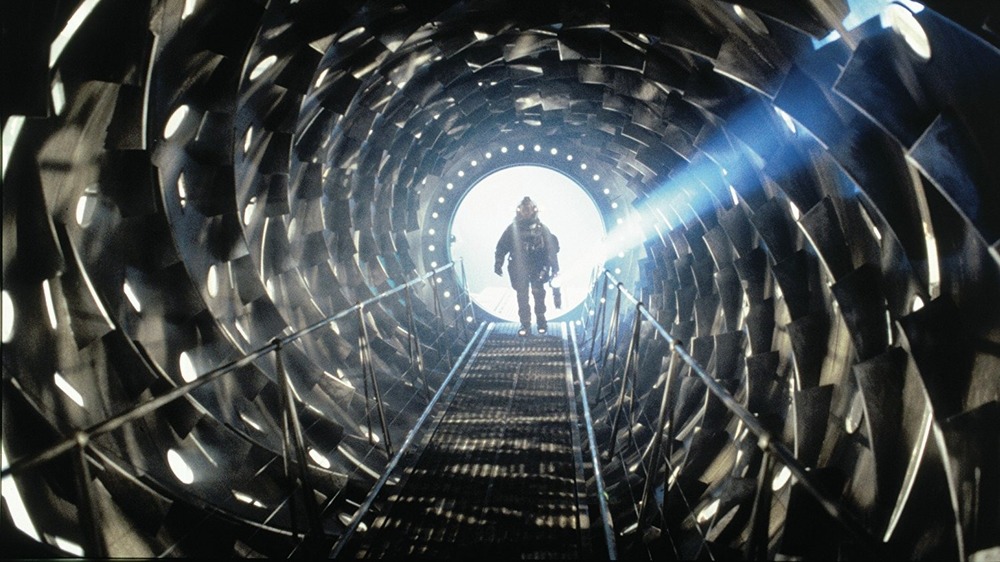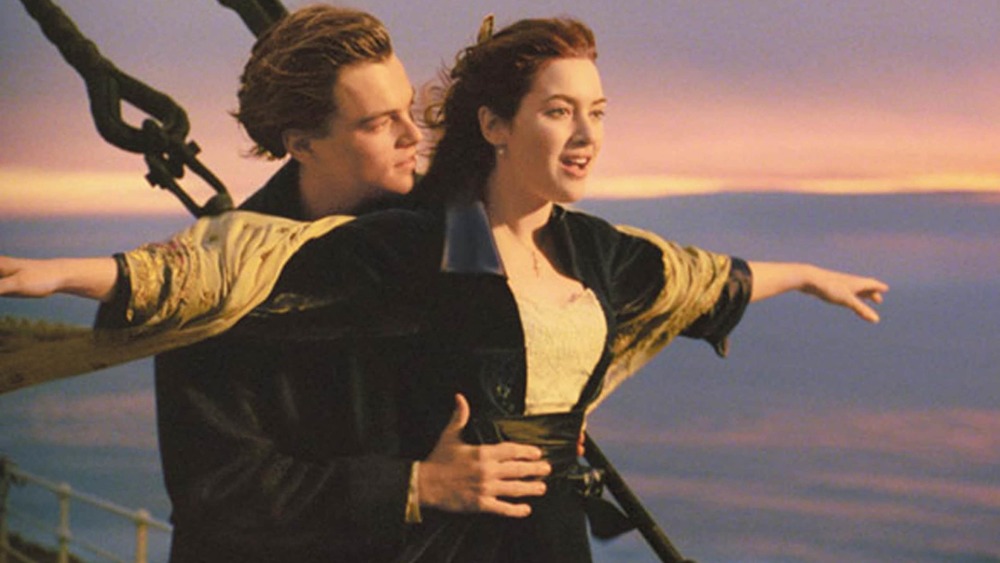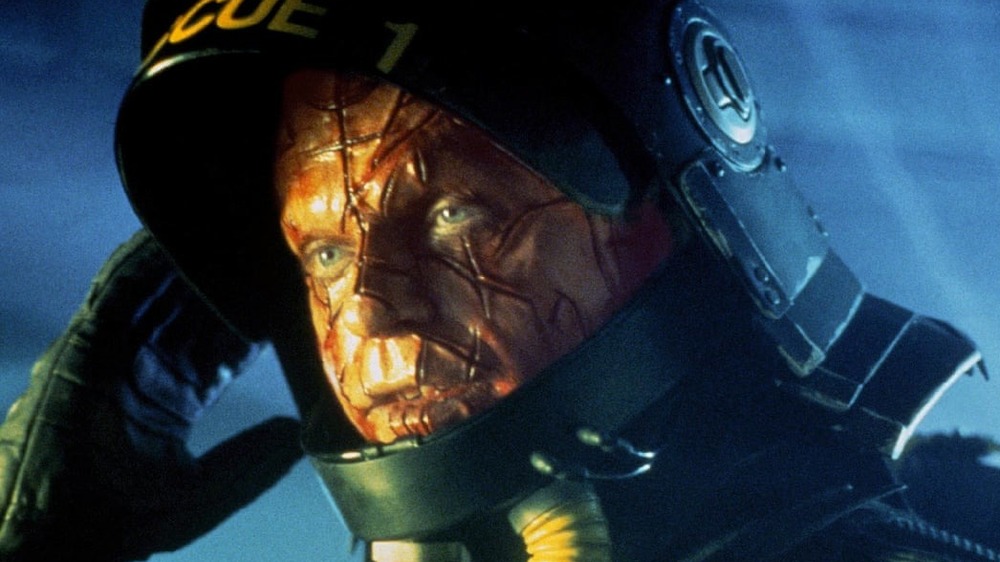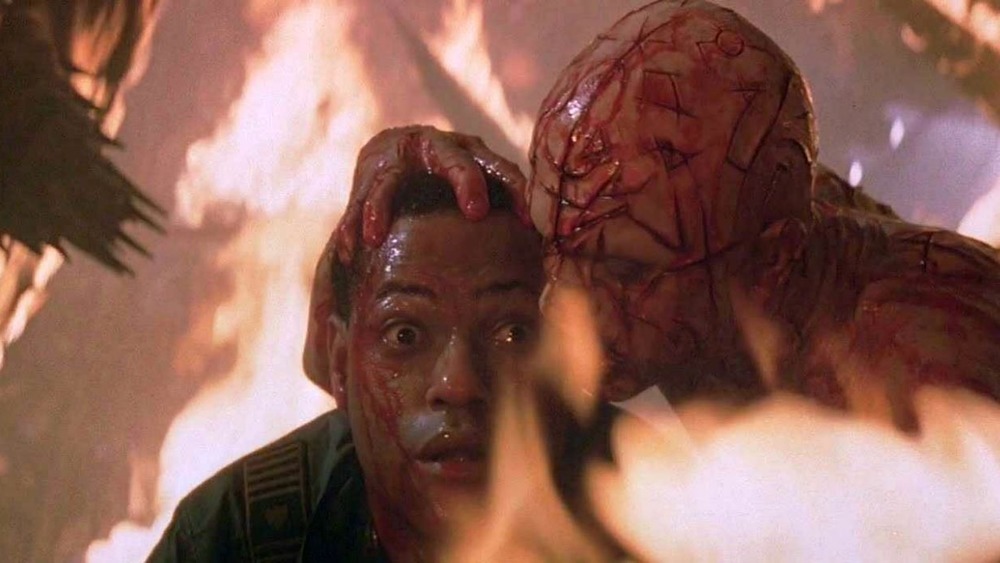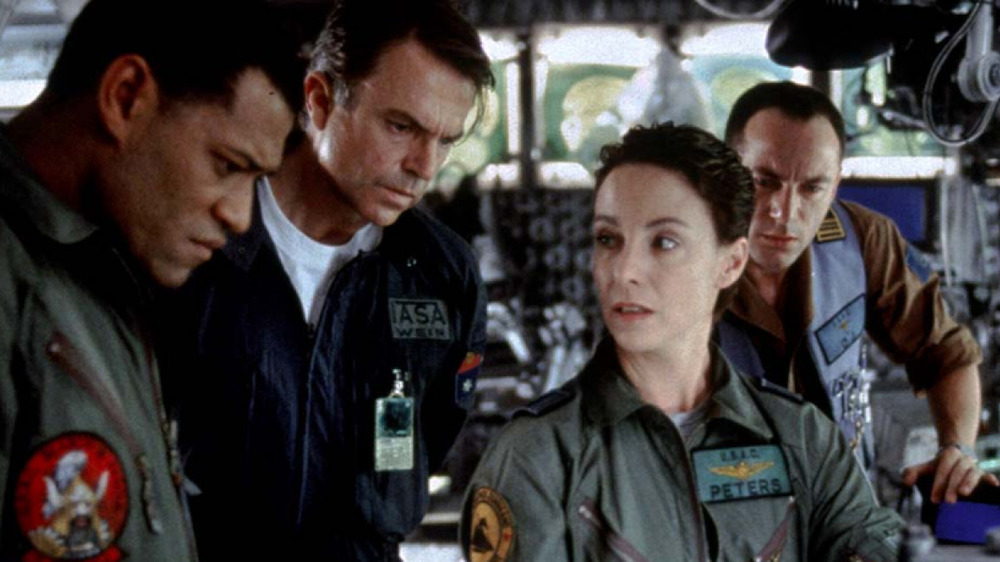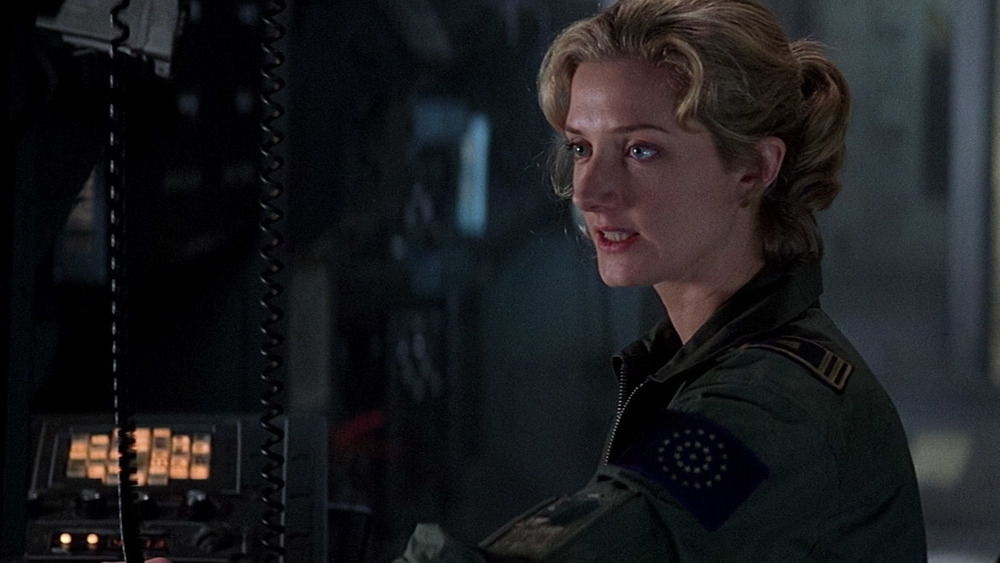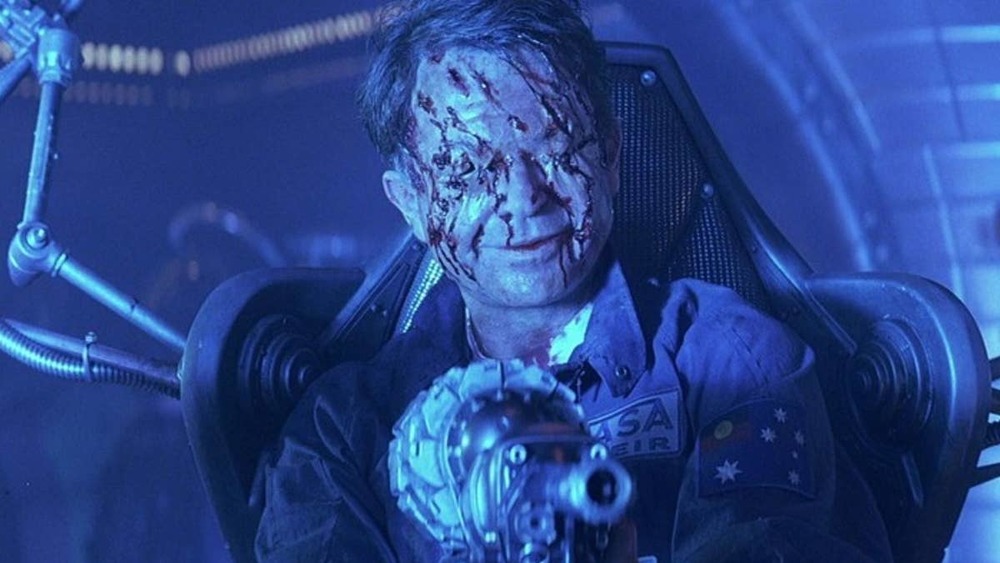The Untold Truth Of Event Horizon
The 1997 sci-fi/horror hybrid Event Horizon is a singularly odd film. It's permeated by an atmosphere of dread, and it features some great performances, as well as some genuinely shocking violence. But one gets the feeling that it isn't quite the film that its director, future Resident Evil series mastermind Paul W.S. Anderson, intended.
The flick tells the story of the Lewis and Clark, a rescue vessel sent to investigate after the spaceship Event Horizon, which had vanished en route to a mysterious destination seven years prior, makes a sudden reappearance, broadcasting a bizarre distress call. Led by Captain Miller (Laurence Fishburne) and Lieutenant Starck (Joely Richardson), the Lewis and Clark encounters the ship, and its crew are forced to board the Event Horizon after an accident damages their own vessel.
What they find on board is disturbing to the extreme, and soon, members of the crew — including Dr. Weir (Sam Neill), the designer of the original doomed ship — begin acting very, very strangely. Thanks to its gruesome imagery and terrifying tone, the film has attained cult status in the years since its release. But the behind-the-scenes story is just as fascinating as the film. So let's take a look back at the troubled production and weird history of a very weird film. Here's the untold truth of Event Horizon.
The director turned down an iconic movie to make Event Horizon
In the mid-'90s, Paul W.S. Anderson was still a relatively green director. His debut feature, the 1994 crime actioner Shopping, was notable mostly for featuring a young Jude Law in his first leading role, and the British flick hardly registered a blip with stateside audiences. But his second film, the 1995 video game adaptation Mortal Kombat, proved to the Tinseltown brass that Anderson could make a profitable genre film on a tight budget. And as such, he was given a choice of projects for his next feature.
One of those projects was X-Men, which would eventually kick off the modern superhero genre under the direction of Bryan Singer. According to Event Horizon's DVD commentary, Anderson was offered the director's chair on X-Men, but he turned it down in favor of making the horror flick. He does admit that it "probably wasn't a good career choice," but he just didn't want to make another PG-13 film. "I definitely had something dark and scary in my psyche to get out," he explained. And so he gravitated toward Event Horizon, the first feature screenplay from scribe Philip Eisner, and he passed on the opportunity to introduce the world to Wolverine and his mutant pals.
Event Horizon was almost an Alien rip-off
Event Horizon's original screenplay needed a little surgery before going in front of the cameras. This is because, in the original version of the script presented to Anderson by studio Paramount, the Event Horizon had brought back something a little too familiar from whatever cursed dimension it had traversed — alien monsters. In the first script, a bunch of evil extraterrestrials had slaughtered the vessel's crew and were hungry for more.
However, Anderson had a something a bit more unique in mind. He wanted to tell a ghost story more along the lines of The Shining, in which the ship itself had attained a wicked form of sentience (via Den of Geek). Anderson was given free rein by the studio to reshape the story as he saw fit, as well as a $60 million budget to bring his vision to life. The director basically took a scalpel to Eisner's script, jettisoning the elements that would've made it little more than a slightly spookier Alien rip-off in favor of an altogether more disturbing angle.
Anderson was influenced by a classic Russian sci-fi movie
In reworking Event Horizon to his liking, Anderson drew heavily on Solaris, a 1972 feature from the Soviet Union based on the 1961 novel by Polish author Stanislaw Lem. Solaris is a meditative, dreamy movie — an art film with few true horror elements — but it's easy to see the influence of its plot all over Event Horizon. In Solaris, a psychologist is sent to examine the crew of a space station that's been orbiting the titular planet for decades. He finds a borderline hostile, uncooperative crew inhabiting a station that's been dangerously neglected, and he soon comes to find that his friend, a scientist who accompanied the original crew, has committed suicide. Then, he begins to see people roaming the halls of the station who aren't supposed to be there — including his late wife.
More than one critic, including the great Roger Ebert, recognized the influence of Solaris on Event Horizon upon its release, and Anderson himself has acknowledged as much. In a 2014 interview with Grantland, the director said, "I love the movies like Solaris, the original Solaris — the script [for Event Horizon] clearly draws from [that film]. Those kind of meditative European films that are unsettling but don't really play to a modern audience. By adding that kind of visceral thrill, that's making it my own." Interestingly, Solaris received the Hollywood remake treatment in 2002, with George Clooney in the lead role and Steven Soderbergh in the director's chair. Sadly, the film flopped mightily, due in part to a confusing marketing campaign.
Anderson used Gothic architecture to build the film's look
Anderson's Solaris-influenced tweak to Philip Eisner's screenplay was diabolically simple. The Event Horizon, designed to travel at faster-than-light speeds by breaching the space-time continuum, had traveled somewhere that it was never meant to go, and in doing so, it had become ... infected. While it's never made crystal clear, the implication is that the ship has literally been to Hell and back. And since that basically made the ship itself the villain of the film, it needed an appropriately ominous design.
Talking with The Ringer, Anderson recalled that for the design of the ship's interior, he drew from Gothic architecture in general and one iconic historical site in particular. "I wanted to do something different that hadn't been done in spaceships before, and because we were telling a Gothic horror story, I reached back in time," the director said. "Using an architectural cam program, we basically built Notre Dame Cathedral in the computer, and then we pulled it apart, and we used different elements of it to build the Event Horizon. So, the towers from Notre Dame became the engine thruster pods."
Thanks to the flick's beefy budget, the entire interior of the Event Horizon was constructed on a cavernous sound stage, and once it was finished, Anderson knew he was on the right track. "[Cast members] would go, 'I love working with you, Paul, but I hate coming to work. It was just horrible," Anderson remembered, going on to explain, "It was actually the sets themselves because the crew couldn't have been nicer. But there was a disturbing vibe. I really felt like we created a very physical haunted house for the actors to interact with."
Event Horizons' director of photography helped cement a 'techno-medieval' aesthetic
Anderson would need a veteran of genre films to effectively shoot his bizarre sets, and he got one in Adrian Biddle, who'd shot such instantly iconic films as Aliens, The Princess Bride, and Thelma & Louise. Biddle immediately understood what Anderson was going for, and with the help of the director and production designer Joseph Bennett, he carefully selected a lighting scheme that would make the Event Horizon appear appropriately futuristic and sterile in cold artificial light ... and take on a whole new personality when bathed in dim light and darkness.
Anderson recalled his DP's contribution in a 2020 chat with American Cinematographer magazine. "We spent a lot of time coming up with a design concept, which we called 'techno-medieval,'" he said. "When the lights are on, everything looks very technological and very spaceship-like. But when the lights go off and the haunting begins, you start looking at the shapes, and the architecture is actually very medieval. We extended that techno-medieval design idea into as many aspects of the picture's look as possible, without rubbing the audience's nose in it."
Biddle opted to use colored gels to augment the film's lighting, a time-honored technique that had fallen out of favor to further heighten the film's sense of unease. "I used some sepia brown coming up from the floor to make viewers uncomfortable on the ship, as well as flashes of red. I also used a lot of green," he remembered. "Cinematographers generally shy away from green, because it's not very pleasant, but on Event Horizon I used gels to produce that nasty, horrible green you get from fluorescents. ... I was going for that kind of an effect, to convey the idea that something not very good is lurking in the ship."
Event Horizon was almost sunk by Titanic
At the time Event Horizon was in production, Paramount was waiting on another film, co-produced with 20th Century Fox, that was running just a bit over schedule, not to mention over budget. It might seem counterintuitive today, but that film — James Cameron's Titanic, which would become the highest-grossing movie of all time — was in no way a sure thing. In fact, Paramount feared that it might have a disaster on its hands befitting the flick's namesake vessel. As such, the studio was hungry for a hit film it could squeeze out in advance of Titanic's debut, and according to The Ringer, it settled on Event Horizon, which presented a slight problem for Anderson and his crew.
The studio shifted production on the film into overdrive, and as a result, Anderson was essentially made to shoot, edit, and oversee visual effects on the film on an insanely tight schedule. Rather than the usual ten weeks allotted for editing, he only ended up with four, forcing him to work nonstop for that entire period. And that's evident in some of Event Horizon's choppy editing work and rough line readings, almost certainly the result of Anderson simply not having time to get as many takes of certain scenes as he otherwise would have.
Test audiences and the studio were shocked by Event Horizon's violence
Against all odds, Anderson was able to slap together a cut of the film that was screened for test audiences and Paramount executives. Those execs had seen dailies that had highlighted the flick's sci-fi elements over its disturbing vibe and graphic violence, but when they got a load of what Anderson had turned in, they — along with the test audiences — had a reaction the director hadn't quite expected. They were, in a word, disgusted.
Anderson remembered the first, disastrous test screening on Event Horizon's DVD commentary. "You can't underestimate the kind of shock that this movie had when it was shown to people," he said. "People were really, really upset by it, even by the level of unpleasantness there is in [the final cut]. I mean, you can just imagine the kind of response to the really hardcore version that we had originally." And as Anderson explained, the studio felt the same way as test audiences. Executives were incredibly "freaked out" by the film's grisly, gruesome nature. As the director put it, "Paramount is the studio that are known for Star Trek franchise, and I don't think that this was quite the space movie that they had anticipated."
Event Horizon's cut footage is the stuff of legend
Just how gruesome was the first cut of Event Horizon? We may never know for sure because, so far, a director's cut of Event Horizon has yet to materialize. After its initial, disastrous test screening, though, Anderson cut over 30 minutes of footage. And according to Den of Geek, much of the deleted footage had to do with the vivid, disturbing hallucinations suffered by the Lewis and Clark's crew once aboard the Event Horizon. In one scene from the final cut, for example, the ship's medical officer, Peters (Kathleen Quinlan), has a vision of her young son with his legs terribly injured. In the original cut, his legs were crawling with maggots.
While these cuts did effectively excise some of the more graphically unsettling moments objected to by the executives, they also had the unintended effect of giving short shrift to the development of the flick's supporting characters, whose fears and anxieties were explored in much more unsettling detail than in the final cut. Other omissions included a giant, Shining-esque torrent of blood spilling forth from a cryogenic tank, and the sight of Dr. Weir — his body riddled with bizarre, demonic carvings — naked and crawling spider-like down a ladder toward the horrified crew.
One cut scene in particular was unbelievably over the top
Event Horizon is notorious for its missing, messed-up scenes. But one deleted sequence in particular — though less than 30 seconds long — really pushed the boundaries. In fact, it likely would've earned the film an X rating had it not been cut down to only a few seconds.
This would be the so-called "bloody orgy" scene. This is the video log discovered by the Lewis and Clark's crew showing the fate of the original crew of the Event Horizon, who literally tore each other apart in an insane storm of sex, violence, and ... well ... violent sex. The scene used real amputees to lend visceral authenticity to images of the Event Horizon's mutilated crew, and Anderson went so far as to hire adult film actors to lend similar authenticity to the images of graphic sex, according to Den of Geek.
We only know these details because of the recollections of special effects supervisor Dave Bonneywell, and his recounting is literally too disturbing to print here. So one can imagine the effect it must've had on those horrified test audiences and studio execs. In a 2017 interview with San Diego Reader, Anderson stated that the footage probably no longer exists ... unless it does, in the form of a VHS tape allegedly owned by producer Lloyd Levin. "I've never managed to watch it — nor has he — because he moved to Spain," the director said. "I travel so much, and we've never been in the same country with a VHS player and him having the cassette in his hands, but I'm very excited about doing it at some point. I'd like to see what's on that tape!"
One of Event Horizon's stars thought the production was cursed
While it's certainly possible that she may have been overstating matters slightly, Joely Richardson was creeped out enough while working on the film that she's said in recent years that she believed the production to be "cursed."
In a chat with Den of Geek (via Film School Rejects), Richardson described how one scene involving her and Neill required multiple takes, all of which ended in the same bizarre fashion. "There was one scene with Sam Neill and me at the console. We were meant to be typing away, and then on a count of three, there'd be a fake explosion, and we'd throw ourselves back off our chairs," she recalled. "When Sam and I did the scene for real, there was the count of three, and then neither of us remember what happened next. The explosion went off, and we woke up a few moments later on the floor. That happened every single time!"
During another scene in which she and Fishburne were required to crawl through a doorway just before a heavy steel door slams shut, Richardson said that due to his vision being obscured by smoke, a special effect technician operated the door just a bit too soon — causing her foot to get stuck in the door. "It was jinxed!" the actress said. "But we all managed to have a laugh regardless."
Critics and audiences hated the film upon its release
Anderson's pared-down cut of Event Horizon was released in August 1997 ... to an absolute critical drubbing. Even today, after having undergone a significant critical reappraisal, it holds a dismal 28% rating on Rotten Tomatoes. Audiences were also turned off, and rather than the late summer hit that Paramount was expecting, the flick turned out to be a massive flop, grossing a mere $26 million — not even half of its budget. (Fortunately for Paramount, the film that the studio had feared was headed for disaster, Titanic, fared just a little better than expected.)
Of course, most cult classics get this kind of initial reception. And while Event Horizon's flaws are many, it can hardly be denied that it's a film that sticks in the craw of viewers like few others. In particular, Sam Neill's unhinged performance is a thing of wonder, and the design of the doomed ship's interiors, complemented by Adrian Biddle's expert camera work, is a remarkable achievement. Still, one can't help but wonder what the film might've been had Paramount not forced Anderson to work on an impossible schedule or if that hellish test screening hadn't gone so poorly.
